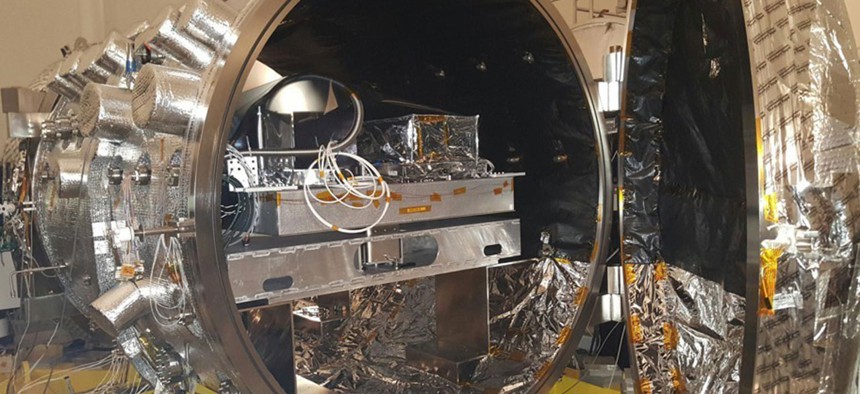
NASA / JPL-Caltech
Budget-Managing Tips, but for Space Telescopes
NASA is scrambling to cut the growing cost of its latest big astronomy mission.
Sometime in the mid-2020s, the United States plans to launch a new member of its fleet of space observatories, one with a field of view 100 times more powerful than the Hubble Space Telescope. The Wide-Field Infrared Survey Telescope, or WFIRST, will spend six years scanning the universe. It will scour the Milky Way in search of hundreds of more exoplanets, and it will soak up the light from distant stars in the hope of understanding, even just a little, the great mystery that is dark energy.
But first, NASA has to figure out how to foot the bill.
The estimated cost of WFIRST has ballooned steadily since astronomers proposed their preliminary designs for the mission in 2011, from less than $2 billion to more than $3 billion. NASA officially began working on WFIRST in February 2016, and staff has spent the months since looking for ways to reduce its price tag. Their efforts went into overdrive in November, thanks to a troubling report from an independent committee that NASA established to help the space agency manage the mission.
The report, provided to WFIRST in October but released publicly for the first time last week, had some sobering words for NASA: The mission, as is, is “not executable” unless they find even more funding. NASA headquarters, in response to the warning, sent a memo to WFIRST folks in October instructing them to find a few hundred millions of dollars in their budget and cut it.
“It’s not fun for anybody,” said Jeffrey Kruk, the project scientist for WFIRST. “It’s very stressful. We’re trying to come up with the right answer, the best answer we can.”
The new report, as well as other official warnings about WFIRST’s rising costs, have provided a rare glimpse into the complicated, nitty-gritty operation behind funding some of NASA’s biggest missions, a process that usually doesn’t spill over into public view. Talk of saving money isn’t unusual in the earliest stages of any mission, but the level of scrutiny the WFIRST project has received so far is.
WFIRST will be the next great space telescope after the James Webb, which is scheduled to launch in spring 2019. Webb, itself the scientific successor to Hubble, will be the most powerful space telescope ever built, charged with spotting the faint light of the earliest stars and galaxies. It’s also been really, really expensive to build. In 2010, NASA estimated the Webb would cost about $5 billion. A year later, the space agency said it would take more than $8 billion. NASA has repeatedly asked Congress for money to cover cost overruns over the years, and the mission has eaten away at resources for other science programs. Officials don’t want a repeat with WFIRST.
“WFIRST, as the next in line, will be subject to scrutiny that 20 years ago it may not have gotten,” said Alan Boss, an astronomer at the Carnegie Institution for Science and one of the many members of the committee that first brought WFIRST to life.
The mission emerged from a decadal survey by the National Research Council, which outlines priorities in astronomy and astrophysics for the United States. WFIRST “presents relatively low technical and cost risk, making its completion feasible within the decade, even in a constrained budgetary environment,” the report said in 2010. This year, the cost reached $3.6 billion, and NASA headquarters is now trying to get it down to about $3.2 billion. The independent review board, however, says that figure is “not realistic for the scope, complexity, and expectations” of the mission, and suspects it’s going to cost more like $3.9 billion.
The particulars of WFIRST’s budget are not publicly available, so it’s not known where exactly all the money is going. But the report attributes the growing cost to several decisions made by NASA, which have created a mission “more complex than probably anticipated.”
Among them is the use of a 2.4-meter telescope, which the National Reconnaissance Office, an agency within the U.S. Department of Defense, donated to NASA for free. WFIRST will use the telescope to feed its main science instruments. One would think a giant gift like this would help considerably, since the WFIRST team wouldn’t have to build their own from scratch. But the telescope is bigger and heavier than the one the team initially envisioned, so it requires more heater power, a bigger spacecraft to hold it, and then a bigger launch vehicle to send it into space. Engineers also have to tweak it to suit their needs for this particular mission. “Having to work with an existing design forces a variety of small engineering choices in ways that can’t be optimized the way one would if starting from a blank sheet of paper,” Kruk said.
Another decision involves an instrument called a coronagraph, which would directly image and study the chemical compositions of exoplanets. At first, the WFIRST team planned to treat the coronagraph as a technology demonstration. This meant that it would do enough science to show its usefulness for future generations of space observatories, but not enough to classify as a full-fledged science instrument. Somewhere along the way, the scientists decided to push the boundaries a little bit—imagine the potential findings of such advanced technology!—and added to its capabilities. That move set the mission up for more planning and testing and eventually got too expensive.
And so the WFIRST team has followed the report’s recommendation to reduce the scope of the coronagraph’s capabilities. “When the gun’s at your head, you realize maybe we could do this a simpler way,” said David Spergel, a Princeton University astrophysicist and cochair of the WFRIST science team. “This pressure, while painful, is actually good.”
Removing the coronagraph altogether would chop $400 million from the total mission cost, but NASA headquarters is intent on keeping it. WFIRST’s main science instrument, a wide-field imager that will investigate dark energy, can’t do detailed analysis of the exoplanets it finds. “The nice thing about the coronagraph is it makes the entire package much more palatable to the public and to congresspeople that are interested in exoplanets,” Boss said. “Getting an image of a nearby planet, to many people, is a lot more interesting than seeing some strange number about dark energy.”
Kruk said most of the cost-cutting this month has come from constant reshuffling of the design, development, and testing schedules. The more things they can do at the same time, the less money they spend. The project is also nearing agreements with other nations, like Canada and Japan, to participate and contribute hardware—$50 million here, another $50 million there, Spergel said.
The WFIRST mission has a busy few months ahead. Next week the House Committee on Science, Space, and Technology will hold a hearing on NASA’s next generation of large telescopes, including Webb and WFIRST, and the recent report on the latter will surely come up. In 2011, Congress placed an $8 billion cap on development costs for Webb. The mission has faced frequent delays, and its launch date has slipped steadily, from the proposed 2014 to 2019. Jeremy Kasdin, a Princeton professor who is leading the coronagraph’s development on WFIRST, is wary of the public making comparisons between the financial histories of the telescopes. “It’s important that people understand it’s not a runaway cost problem like the [Webb telescope] was, he said.”
In February, WFIRST scientists will present to headquarters their latest designs and science objectives, and, if approved, will move the project onto the next phase of development. By that time, they need to hit the $3.2 billion target, too. So far, the scientists I spoke with seem confident about cutting enough costs. They just know it’s going to hurt.
“The problem is astronomers always want to make the best possible instrument they can and engineers are happy to oblige them because engineers get their jollies making something work really well in space,” Boss said. “But unfortunately, they also charge you for it.”







